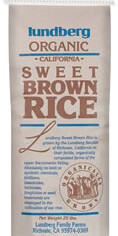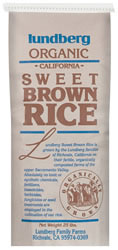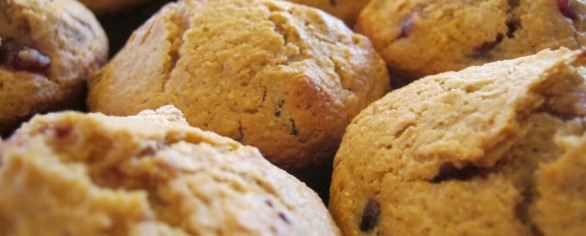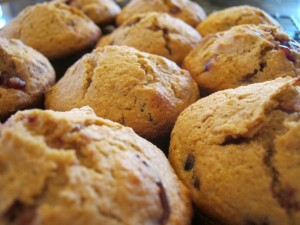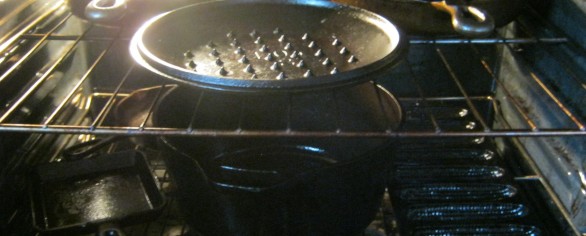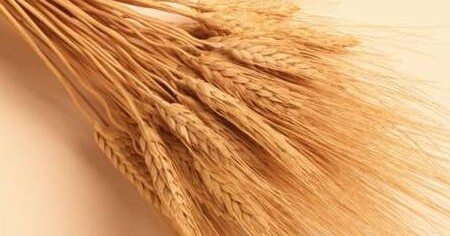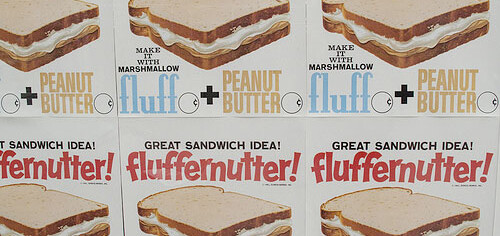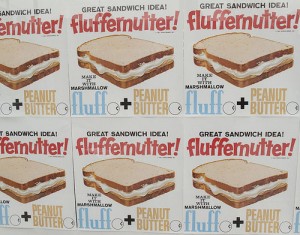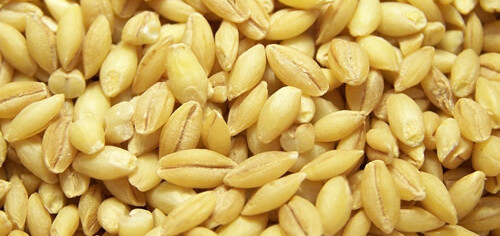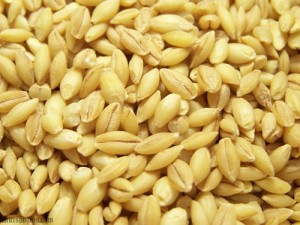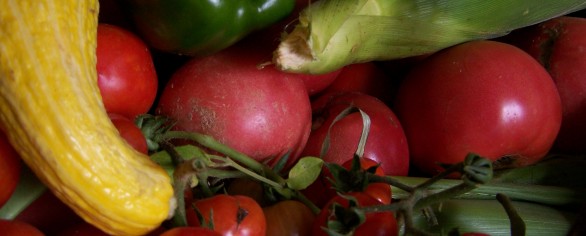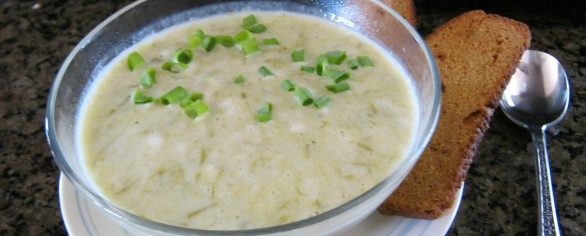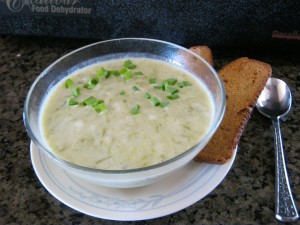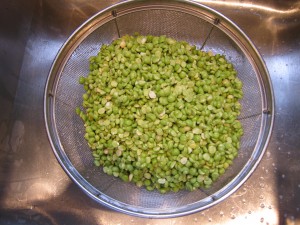By now, you’ve likely heard the drastic affects that will take place on our food costs shortly after 2013 begins. Don’t let the pending price hike catch you off guard.
If you are in our area – check to see if you’re on the delivery route. If you’re not, we do ship orders out of our area (usually under 70lbs) with a shipping carrier of your choosing (USPS or UPS).
Stock up now by buying bulk foods before the squeeze is put on your pantry budget for the new year.
Delivery Route Dates:
Orders Shipped Out of Delivery Area:
Best Blessings!
Joseph & Donna Miller, Owners
Millers Grain House Bulk Delivery Route Site
Thank you for allowing us to serve you. It is our pleasure!
Deut 28:5 – “A blessing upon your grain-basket and kneading-bowl.”
Feel free to contact our office via email or call during business hours.
Mon – Thurs 9:00-5:00, Fri 9:00-4:00 Eastern Time (Closed Sat & Sun)
828.536.4988
Come Visit the NEW Millers Grain House –https://www.millersgrainhouse.com
Video Encouragement – http://www.youtube.com/MillersGrainHouse
Encouragement in the Kitchen – http://www.blogtalkradio.com/millersgrainhouse
You know that phrase made famous by the Vikings in the Capital One commercial? “What’s in Your Wallet?” – Well, let me ask: “What’s in YOUR Fridge?”
On any given day that may be a scary question for some – but for most of us after  Thanksgiving, it’s not only scary, it’s a downright daunting and overwhelming question!
Thanksgiving, it’s not only scary, it’s a downright daunting and overwhelming question!
The answer is a resounding LEFT OVERS!
When faced with a myriad of foods that you don’t normally eat during the year, left in odd amounts hiding or sliding around after Thanksgiving, some of us may be tempted to toss the left over food, given the turkey coma we have just induced. But do not despair… There are many things you can do with left over Thanksgiving goodies so you won’t waste your food budget by feeding it all to the dog.
Mashed Potatoes:
Portion them out into one cup servings, into baggies and freeze. When you need to thicken a soup, top a pot pie or simply have a quick side dish (seasoned with cheese, chives, garlic, etc) – these are quickly thawed and used.
Sweet Potato Casserole:
Portion this out into one half cup servings, into baggies and freeze. These make great additions for muffins and can be added in to winter squash soups. Again they are a stand alone side dish at a far later date.
Green Bean Casserole:
Given that this is usually laden with mushroom soup and fried onions – it usually doesn’t keep well for too long. Plan on tossing this into your turkey pot pie as an added green veggie and cream soup base. The onions will soften and blend with the other ingredients…no one will know that you used it there.
Cranberry Relish/Jelly:
Also another great add-in for muffins. It turns your muffins a sweet pink and you don’t have to add as much sugar as the usual recipe.
Turkey:
I’m not sure why we always have way more turkey than I think we will. After days of turkey sandwiches – it’s still HERE! So here are some thoughts…
Break the bones with the meat on them, boil and make broth that can be frozen or canned.
Then de-bone all the meat you can glean (we ended up with a gallon bag of bits) and make any number of things such as turkey and rice soup, turkey pot pie, turkey salad for wraps or sandwiches, turkey tacos (use taco seasonings), turkey barbeque on a whole wheat bun. Yes, all of these are on the menu for the next few weeks at our home. Simply label and freeze portion sizes to make the specific meal.
Once you’ve tended to the left overs and they are in their proper place (not hiding in the fridge or trashed) you can move on to some more ‘normal’ meals and enjoy the fact that you can give Thanks for having this other food on hand!
 Donna Miller is a teacher, author, sought-after speaker and trainer. She has been a both guest and host on internet and broadcast radio talk-shows and in television interviews. She enjoys teaching online and local classes & ladies retreats for people to learn whole food cooking, budget friendly techniques and preparedness skills. Donna is happily married and has three adult children, and a daughter in-law. She and her husband (Joseph) are the founders of both Millers Grain House , Your Preparation Station and are on the board of PREPARE Magazine.
Donna Miller is a teacher, author, sought-after speaker and trainer. She has been a both guest and host on internet and broadcast radio talk-shows and in television interviews. She enjoys teaching online and local classes & ladies retreats for people to learn whole food cooking, budget friendly techniques and preparedness skills. Donna is happily married and has three adult children, and a daughter in-law. She and her husband (Joseph) are the founders of both Millers Grain House , Your Preparation Station and are on the board of PREPARE Magazine.
On a windy, wet and snowy day – one of my favorite things to do is season my cast iron ware. This ‘chore’ takes on a warm-the-house feeling when I choose to do it in the winter. So it’s not at all a drudgery for me.
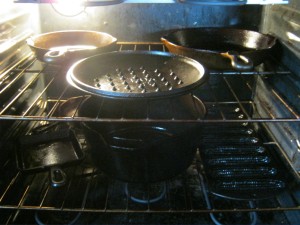 What is ‘seasoning’ you may ask? It’s simply the act of creating an oil coating on the porous cast iron so that the foods cooked in it don’t stick. People use many different oils (solid fats and liquids) to season their cast iron.
What is ‘seasoning’ you may ask? It’s simply the act of creating an oil coating on the porous cast iron so that the foods cooked in it don’t stick. People use many different oils (solid fats and liquids) to season their cast iron.
We have a favorite two oils we use: Grape seed Oil or Coconut Oil. We use these because of their higher smoke point.
How we season our cast iron:
- Be sure the cast iron item is clean by scrubbing with very hot water and a wire brush, plastic brush or steel wool – no soap – EVER because the pan will soak up the suds and ruin. Water is alone all that is needed.
- Situate the racks in the oven to fit all sizes of the cast iron. Preheat the oven to 35O degrees.
- Generously pour the oil or grab a ‘glob’ of solidified oil and spread all along the interior, exterior and handle of the cast iron ware. Now some folks like to use a paper towel or a brush to do this…not me, I like to use my hands. This way I can feel if there are any bits of food left or flaws that need extra oil (to avoid rust). Plus, it moisturizes my hands.
- Be sure there are no puddles of oil, but that it is smoothly and evenly distributed.
- Place all the cast iron in on the racks and turn it off. Some folks say to put it in upside down, we don’t do that because I don’t want any oils dripping directly on the heated coils of the oven.
- After the oven and the cast iron wares have cooled, rub one more time to be sure to distribute any oils. Store in cabinet and you’re ready for use at any time!
Using cast iron is one of the most healthy ways to have a non-stick surface, add trace amounts of iron into your diet and, create an heirloom piece of kitchen ware that will out last you – that can be handed down to the grand-kid’s grand-kids.
________________________________________________
 Donna Miller is a teacher, author, sought-after speaker and trainer. She has been a both guest and host on internet and broadcast radio talk-shows and in television interviews.
Donna Miller is a teacher, author, sought-after speaker and trainer. She has been a both guest and host on internet and broadcast radio talk-shows and in television interviews.
She is the hostess of “Your Preparation Station” on Preparedness Radio Network. She and her husband are the Organizers of WNC Preparedness Group in Asheville, NC. She is an Adjunct Instructor for Frontier Christian University. She teaches local classes & ladies retreats for people to learn hands skills.
She and her husband are the founders of Millers Grain House and, Your Preparation Station and are on the board of PREPARE Magazine.
Joseph and Donna have been happily married for 27 years and have three adult children, and one daughter in-law.
________________________________________________
|
Sure. Maybe you thought that today was only Columbus Day, but nay there is a more pertinent holiday that just begs to compete with the accidental finding of our home land…and that is National Fluffernutter Day.
No. This is not another word from the movie Mary Poppins, but a real iconic sandwich (or variation there of) using peanut butter and marsh mallow fluff.
Although not a healthy food as depicted in the photo to the left, on white bread, it is often associated fondly with the nostalgia of childhood and thus, to me means we can grow it up a bit by making it healthier and still enjoy some of the fun too!
So let’s look at how to do this:
First – please try your hand at making your own PEANUT BUTTER. It’s easy and often less expensive. It also lacks those awful hydrogenated oils of the store bought variety. Also by using some Stevia vs. all Sugar (as the video linked above shows) you cut down on the sugar intake. Of course that ‘s a mute point was we get to the other ingredient… Marshmallow Creme, but oh well.
Marshmallow Creme is what it is. Although the one benefit is that it is a no fat food! So there, feel healthy. (o:
The last needed ingredient for your Grown-Up, Healthified, Fluffernutter Sandwich would be freshly milled 100% whole wheat bread. Here’s the recipe. If it’s made from home with all ingredients you can pronounce it’s much healthier.
Now put that sandwich together (go sparingly on the fillings, remember they do ooze) and just enjoy!
A few other options to enjoy National Fluffernutter Day are:
– Put home-made PB and Fluff on a Rice Cake
– Put home-made PB and Fluff on a Whole Wheat Pancake
– Put home-made PB and Fluff in between crackers.
It’s an odd food holiday…but a fun one we can still enjoy just a little bit if we put on our thinking caps.
We were recently asked this question. We hope that by sharing the anwer with you – we are able to help you as well.
Hi guys. Love the info! My storage spot is the garage but Summer gets hot. Am I ruining the grains I’m starting to store?
————————
Answer:
Thank you for contacting us and for your kind remarks! We’re delighted to be of service.
Ruining? Not really. But you may be shortening the life of them.
Grain stays intact and fully nutritious at approx 80degrees at the hottest. Over that temp it begins to decompose/breakdown.
If the wheat germ oil inside gets consistently hot then cool then hot then cool it will make the wheat bitter tasting and thus, not so good when you go to use it. It may also not ‘act’ like regular flour either due to the density of the oil after prolonged heat.
Indoors. In dark or no exterior windows. Dry. Away from any heat source. No hotter than 80 degrees F. Is the optimum way to store grain to last for hundreds of years.
Hopefully this helps answer your question!
—
Joseph & Donna Miller, Owners
Millers Grain House
Thank you for allowing us to serve you. It is our pleasure!
Deut 28:5 – “A blessing upon your grain-basket and kneading-bowl.”
Feel free to contact our office via email or call during business hours.
Mon – Thurs 9:00-5:00, Fri 9:00-4:00 Eastern Time (Closed Sat & Sun)
 1.828.536.4988
1.828.536.4988
Come Visit the NEW Millers Grain House – https://www.millersgrainhouse.
Free Video Encouragement – http://www.youtube.com/
Free Radio Show – Encouragement in the Kitchen – http://www.blogtalkradio.com/

Consumers practically need a PHD to read the labels on boxed items, so buying whole foods is usually easier to decipher right? Not always. We practically need a decoder ring to clarify those tiny stickers on produce.
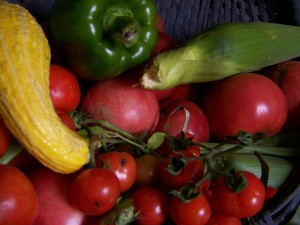 Have you ever tried to figure out what is the most healthy produce to buy? An apple is an apple is an apple, right? Well, maybe not. Let me help you with decoding the produce codes.
Have you ever tried to figure out what is the most healthy produce to buy? An apple is an apple is an apple, right? Well, maybe not. Let me help you with decoding the produce codes.
A great way to identify organic products, which must be produced without the use of antibiotics, synthetic hormones, genetic engineering and other excluded practices, is to look for the USDA organic label. There is a wide amount of wiggle room on percentages and understanding of USDA regulations for learning what these seals mean, so we will discuss the USDA organic labeling and seal in a separate blog.
Most produce in the market has a small sticker or a bar code with 4 to 5 numbers. It’s time to take out your decoder ring, your paper and pencil and put on your spy glasses and trench coat.
We’re going to take a look at just the first number to know what you are getting:
- If it starts with the number “8” at the front of a (usually) five digit number = It is Genetically modified (DNA altered) and is not grown organically or certified organic (has pesticides).
- If it starts with the number “9” it is usually a five digit number = It is Organically Grown and non GMO.
- If it starts with “3 or 4” and usually a four digit number = It is conventionally grown (with some pesticides), not usually genetically modified (thus is non-GMO), but is not grown organically or certified organic (has some pesticides).
In closing, I shall leave you with a (cheesy) little rhyme to use instead of the spy garb to help you remember how to decipher the produce codes:
The number nine (9) is always fine.
Three or four (3 or 4) might be allowed through the door.
If you can come up with a better memory system, by all means please HELP ME and please leave a comment!! (o:
Best Blessings!
Donna Miller, Owner of Millers Grain House
I’ll be the first one (okay, no my FAMILY would be the first ones) to tell you that I used to HATE admitting I made mistakes! To the point of vehemently arguing that it was not a mistake at all (even if I really knew I’d made a major booboo). Years, maturity and wisdom finally worked into my thick skull (and God worked on the pride thing) and I actually now embrace (some of) the mistakes I make as abilities to grow and learn. The kitchen is one of those areas in which I actually love to make mistakes. As long as no one gets hurt.
Today we are doing the Miller House tradition of Fridge Purge. Which means – I am not going to buy more refrigerated groceries until we make some room. So meals get creative. I had about 8 stalks of cooked asparagus that no one was going to eat and would be headed for the trash by Saturday if I didn’t come to the rescue and FAST.
Also – several days ago I had a failed attempt at Sour Dough Bread. Don’t ask me why but that stuff alludes me every time. But no way was I tossing that whole loaf out just because it was squatty. So it became Melba Toast (in the Excalibur Dehydrator). All I did was slide the loaf very thin. Brushed both sides with a tad bit of olive oil and dehydrated until crispy.
So here is the super frugal lunch that came out of it my mistakes and left-overs:
Please don’t ask for a real specific recipe – because I measured nothing – just started tossing in the ingredients and out came a very creamy, delicious Cream of Asparagus Soup (with Melba Toast) for two!
Basically it was the 8 cooked spears in enough fat-free milk to cover, cooked on low until softened. Added about 1tsp of garlic grape-seed oil and seasoned with garlic salt, onion salt and savory to taste. Then let simmer just a few minutes.
With a stick blender, I whirred the mixture until most of the spears were ground up nicely. I then took 1/4 cup(ish) of cold milk and mixed about 2tsp of Arrow Root Powder into it – poured that mixture into the hot soup and stirred until thickened.
Put it in the bowl, topped with fresh chives and two home-made Melba-Toast by mistake slices for dipping and Tah-Dah! I took that picture to share lunch with you! (o: The other serving went to my particularly picky daughter – who actually liked it!
It actually tasted like it had a cheese base but it didn’t. For those who are dairy free – we you could use non-flavored or sweetened rice milk, almond milk or coconut milk.
For more photos of this visit our Millers Grain House Facebook Page – and “LIKE” the page to see more!
I hope you don’t throw out your mistakes or you tiny little left-overs *until they grow stuff on them or smell bad* – but that you use your imagination to embrace your mistakes and make something surprisingly pleasant out of them!
Best Blessings!
Donna
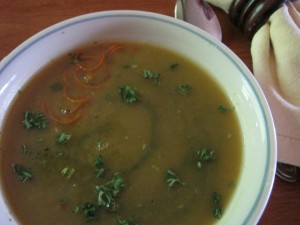 Typically a cold weather food, Split Pea Soup is a hearty meal that can be made entirely from foods that are stored for long term. Split peas last for a year or more in the pantry. Dehydrated carrots, onions and spices are also long term food storage items. If you can your own veggie or chicken broth, or purchase granules or bullion cubes then you’re set. Nothing has to be “in season” to make this filling soup.
Typically a cold weather food, Split Pea Soup is a hearty meal that can be made entirely from foods that are stored for long term. Split peas last for a year or more in the pantry. Dehydrated carrots, onions and spices are also long term food storage items. If you can your own veggie or chicken broth, or purchase granules or bullion cubes then you’re set. Nothing has to be “in season” to make this filling soup.
Here is the recipe and the steps.
Ingredients:
- 1/2 Cup shredded or diced dehydrated Carrots
- 1/4 Cup diced dehydrated Celery
- 1/4 Cup diced dehydrated Onions
- 1/2 Cup dehydrated Potato Cubes(optional)
- 2 Cups Split Green Peas
- 1 TBS Olive Oil
- 1 TBS Garlic Salt
- 1/8-1/4 tsp Cayenne
- 1/4 tsp Cumin
- 2 Quarts of Soup Stock (veggie or chicken or water/bullion equivalent)
First – soak 2 Cups of Organic Split Green Peas over night
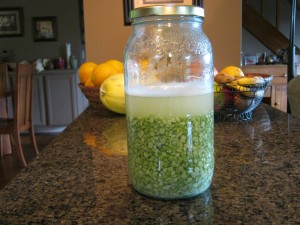 Don’t worry. They will likely look a little ‘frothy’ in the morning, but this is normal.
Don’t worry. They will likely look a little ‘frothy’ in the morning, but this is normal.
Just be sure before you go to sleep that you have covered the Split Peas with more than double their height in water. For example, if the peas are about 4 inches in depth, put 8 inches of water ABOVE THE TOP. Twelve inches all together. Because the peas will soak up a LOT of liquid over night making them easier to cook to smooth the next day.
After soaked, drain them before moving on with the rest of the recipe.
Mean while, back at the soup pot: Add about 1 Cup of the liquid to the base of the soup pot, put in all of your dehydrated veggies and let soak for a little while (approx 30 minutes).
Now add remaining liquid/broth, Drained Split Peas and spices. Cook on low heat for 2-4 hours. Stirring occasionally.
Either use a stick blender and put in the pot whirring until creamy or transfer by one cup at a time to a blender to blend most of the soup to creamy. For a chunkier soup, blend only half of the soup and leave the rest as is. Combine. For a smoother soup, blend it all. Serve hot.
Serve with freshly baked bread for a real treat.
This can even be pre-made with the dry ingredients in a cute little gift jar. Simply put the Split peas as the base and a small decorative bag full of the other dehydrated foods combined with the herbs as a topper inside the jar.
EnJOY!
Home 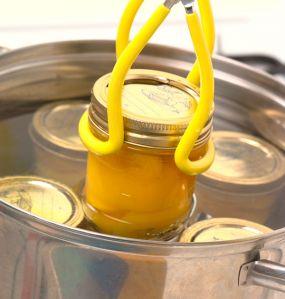 Canning has been around for far longer than our store-bought canned products of today. It is an old skill that is making a come back during these tougher than normal economic times. And why not? Buying fresh foods and learning how to make them last long into the next few seasons is often the most economical way to eat without attempting to live off of preservative laden boxed mixes.
Canning has been around for far longer than our store-bought canned products of today. It is an old skill that is making a come back during these tougher than normal economic times. And why not? Buying fresh foods and learning how to make them last long into the next few seasons is often the most economical way to eat without attempting to live off of preservative laden boxed mixes.
The history of canning can be traced back as far as Napoleon Bonaparte in the 18th century. He experimented for over 15 years and finally realized that if food is sufficiently heated and sealed in an airtight container, it would not go bad. Wine was among his very first commodities to attempt to preserve in this manner. I mean, priorities are priorities, right?
Although this skill may seem a bit old fashioned it is gaining new ground as grocery prices rise. Men and Women from their 20’s to their 60’s are learning this fine art of food preservation. It is as safe as it is ‘green’ (earth friendly). The cans are reusable glass and do not leach BPA into the food like the white lining of the commercial cans do. Even the lids don’t have to be tossed if you purchase the Tattler Lids (also BPA free). This is much better on our environment and our bodies.
The difference between water bath canning and pressure canning is easily determined by the acidity of the food. There are several good (and reasonably priced) books to help you know which method to use and how long to process the food. There are also tools of the canning trade that you can get for less than you may think, making the home canning process an old skill that will help you stretch your food bill for seasons to come.
With a little practice, you can easily both pressure can or water bath can almost every single food you may need. The food then stores for years without the aid of electricity.
If I can can – then you can can – we can all can!
Blessings and enJOY the journey!

